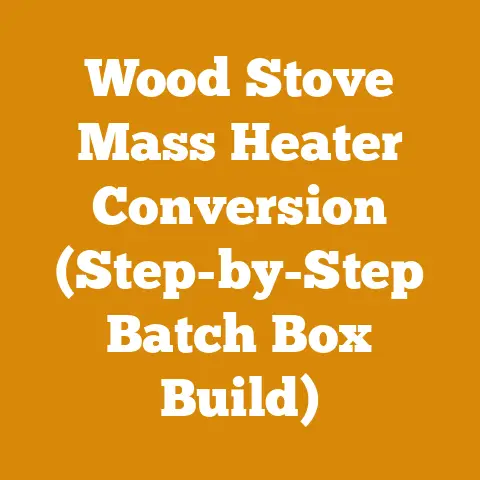Big End Bearing Repair (5 Pro Tips for Engine Rebuilders)
Ever taste defeat when a machine you rely on grinds to a halt? It’s a bitter pill, especially when it hits you in the wallet and the workday. For engine rebuilders like myself, the big end bearing – that crucial component nestled deep within the heart of an engine – can be the source of many headaches. It’s a high-stress area, vulnerable to wear, tear, and the occasional catastrophic failure. That’s why understanding big end bearing repair is not just important; it’s absolutely essential.
In this article, I’ll share five pro tips gleaned from years of experience, countless engine rebuilds, and a healthy dose of trial and error. We’ll be diving deep into the world of engine bearings, covering everything from diagnostics and selection to installation and troubleshooting. Whether you’re a seasoned pro or a DIY enthusiast, you’ll find valuable insights to help you keep those engines purring like a kitten – or roaring like a lion, depending on your preference!
Understanding the Importance of Big End Bearings
Big end bearings, also known as connecting rod bearings, are the unsung heroes of the internal combustion engine. These bearings sit between the connecting rod and the crankshaft, allowing the rod to rotate smoothly around the crankshaft journal. They are responsible for transmitting the immense force generated by combustion, turning linear motion into rotational power.
Without properly functioning big end bearings, the entire engine is at risk. Excessive wear can lead to engine knocking, reduced power, and eventually, catastrophic engine failure. Ignoring warning signs can result in costly repairs, including crankshaft replacement, connecting rod damage, and even complete engine rebuilds. In extreme cases, a failed big end bearing can cause the connecting rod to break, sending it crashing through the engine block – a scenario every engine rebuilder dreads.
I’ve seen firsthand the devastation a neglected big end bearing can cause. I once worked on an old logging truck where the owner had ignored the tell-tale signs of bearing wear for months. The resulting damage was extensive, requiring a complete engine overhaul that cost him thousands of dollars.
Pro Tip 1: Master the Art of Diagnosis
The first step in any successful big end bearing repair is accurate diagnosis. Identifying the problem early can save you time, money, and a whole lot of frustration.
Recognizing the Symptoms
The most common symptom of worn big end bearings is engine knocking, often described as a distinct “thumping” sound that increases with engine speed. This sound is caused by excessive clearance between the bearing and the crankshaft journal, allowing the connecting rod to move back and forth.
Other symptoms include:
- Reduced Oil Pressure: Worn bearings increase oil clearances, leading to a drop in oil pressure.
- Metallic Debris in Oil: As bearings wear, they shed metallic particles into the oil.
- Engine Vibration: Excessive bearing wear can cause engine vibration, especially at higher RPMs.
- Increased Engine Temperature: Friction from worn bearings can lead to increased engine temperature.
Using Diagnostic Tools
Several tools can help you diagnose big end bearing problems:
- Oil Pressure Gauge: Monitor oil pressure to identify drops that may indicate bearing wear.
- Oil Analysis: Send an oil sample to a lab for analysis to detect metallic debris.
- Stethoscope: Use a stethoscope to listen for engine knocking and pinpoint the source of the noise.
- Compression Test: A compression test can help identify cylinder-specific issues that may be related to connecting rod problems.
- Plastigauge: This is a crucial tool for measuring bearing clearance during installation.
Case Study: Diagnosing a Knocking Engine
I once encountered a classic example of a knocking engine. A customer brought in a pickup truck complaining of a loud knocking noise that worsened under load. Using a stethoscope, I quickly pinpointed the source of the noise to the lower end of the engine. An oil pressure check revealed slightly lower than normal pressure.
Suspecting a big end bearing issue, I dropped the oil pan and inspected the connecting rods. Sure enough, one of the bearings showed significant wear, with visible scoring and excessive clearance. The crankshaft journal also showed signs of damage. This early diagnosis prevented further engine damage and allowed me to recommend a targeted repair.
Data Point: The Cost of Neglect
According to a study by the Automotive Aftermarket Industry Association (AAIA), neglecting engine maintenance can increase repair costs by as much as 50%. Early diagnosis and repair of big end bearing problems can prevent more extensive and expensive engine damage.
Pro Tip 2: Selecting the Right Bearings
Choosing the right big end bearings is crucial for engine performance and longevity. Not all bearings are created equal, and selecting the wrong ones can lead to premature wear and failure.
Understanding Bearing Materials
Big end bearings are typically made from a combination of materials, each offering specific advantages:
- Aluminum-Tin Alloys: These alloys offer good fatigue strength and corrosion resistance, making them suitable for high-performance engines.
- Copper-Lead Alloys: These alloys provide excellent load-carrying capacity and are often used in heavy-duty applications.
- Tri-Metal Bearings: These bearings consist of a steel backing, an intermediate layer of aluminum or copper alloy, and a thin overlay of lead-tin or lead-indium. The overlay provides excellent conformability and embeddability.
- Polymer Bearings: These bearings are made from advanced polymers and offer excellent wear resistance and low friction. They are often used in modern engines.
Considering Engine Application
The type of engine and its intended use should influence your bearing selection. For example:
- Daily Drivers: For everyday vehicles, standard replacement bearings made from aluminum-tin or copper-lead alloys are typically sufficient.
- High-Performance Engines: For high-performance engines, consider using tri-metal bearings or bearings made from advanced alloys that can withstand higher loads and temperatures.
- Racing Engines: Racing engines require specialized bearings designed for extreme conditions. These bearings often feature unique materials and coatings to minimize friction and maximize durability.
- Heavy-Duty Applications: Trucks, buses, and other heavy-duty vehicles require bearings with high load-carrying capacity. Copper-lead alloys and tri-metal bearings are often preferred in these applications.
Understanding Bearing Clearances
Bearing clearance refers to the space between the bearing and the crankshaft journal. Proper bearing clearance is essential for oil film formation and lubrication. Too little clearance can lead to overheating and bearing seizure, while too much clearance can result in engine knocking and reduced oil pressure.
Bearing clearance is typically measured using Plastigauge, a crushable plastic thread that is placed between the bearing and the crankshaft journal. After tightening the connecting rod bolts to the specified torque, the Plastigauge is removed and measured to determine the bearing clearance.
Data Point: The Importance of Proper Clearance
According to a study by the Society of Automotive Engineers (SAE), maintaining proper bearing clearance can increase engine life by as much as 25%.
Personal Experience: Choosing the Right Bearings for a Restoration Project
I recently worked on restoring a classic muscle car. The engine was a high-performance V8 that had been heavily modified. After consulting with the owner and researching the engine’s specifications, I decided to use tri-metal bearings with a slightly tighter clearance than stock. This choice provided the necessary load-carrying capacity and oil film thickness to ensure reliable performance under demanding conditions.
Pro Tip 3: Mastering the Art of Installation
Proper installation is just as important as selecting the right bearings. Even the best bearings will fail prematurely if they are not installed correctly.
Preparing the Surfaces
Before installing new bearings, it’s crucial to thoroughly clean and inspect all mating surfaces. This includes the connecting rod, connecting rod cap, and crankshaft journal.
- Cleaning: Use a solvent to remove any dirt, oil, or debris from the surfaces.
- Inspection: Check for any signs of damage, such as scratches, dents, or corrosion. Minor imperfections can be removed with fine emery cloth, but more serious damage may require machining or replacement.
- Crankshaft Journal Polishing: The crankshaft journal should be polished to remove any minor imperfections and ensure a smooth surface for the bearing.
Installing the Bearings
- Orientation: Ensure the bearings are installed with the correct orientation. Most bearings have a locating tang that must be aligned with the corresponding notch in the connecting rod and cap.
- Lubrication: Apply a generous amount of assembly lube to the bearing surfaces before installation. This will help prevent dry starts and reduce friction during the initial break-in period.
- Torqueing: Tighten the connecting rod bolts to the manufacturer’s specified torque. Use a torque wrench to ensure accurate and consistent tightening.
- Checking Clearance: After tightening the bolts, check the bearing clearance using Plastigauge. If the clearance is not within the specified range, you may need to use undersized or oversized bearings.
Avoiding Common Mistakes
- Over-Torquing: Over-torquing the connecting rod bolts can damage the bearings and distort the connecting rod.
- Contamination: Contamination with dirt or debris can damage the bearings and reduce their lifespan.
- Incorrect Orientation: Installing the bearings with the wrong orientation can prevent proper oil flow and lead to premature failure.
- Reusing Old Bolts: Always use new connecting rod bolts when installing new bearings. Old bolts can stretch and weaken, leading to reduced clamping force and potential failure.
Data Point: The Impact of Proper Torque
According to a study by the American Society of Mechanical Engineers (ASME), proper torqueing of connecting rod bolts can increase bearing life by as much as 30%.
Personal Experience: A Lesson in Cleanliness
I once rushed through a bearing installation and failed to thoroughly clean the connecting rod. A small piece of debris became lodged between the bearing and the connecting rod, causing the bearing to fail within a few hundred miles. That experience taught me the importance of cleanliness and attention to detail during bearing installation.
Pro Tip 4: Understanding Oil and Lubrication
Oil is the lifeblood of an engine, and proper lubrication is essential for big end bearing survival. Choosing the right oil and maintaining a healthy lubrication system can significantly extend bearing life.
Selecting the Right Oil
- Viscosity: Choose an oil with the correct viscosity for your engine and climate. Refer to the manufacturer’s recommendations for the appropriate viscosity grade.
- Additives: Look for oils with additives that provide wear protection, corrosion resistance, and detergency.
- Synthetic vs. Conventional: Synthetic oils offer superior performance and protection compared to conventional oils. They provide better high-temperature stability, reduced friction, and longer drain intervals.
- High-Mileage Oils: For older engines with high mileage, consider using a high-mileage oil that contains seal conditioners and extra wear protection additives.
Maintaining the Lubrication System
- Regular Oil Changes: Change your oil and filter regularly according to the manufacturer’s recommendations.
- Oil Filter Selection: Use a high-quality oil filter that can effectively remove contaminants from the oil.
- Oil Pressure Monitoring: Monitor your oil pressure regularly to identify any drops that may indicate a problem with the lubrication system.
- Checking for Leaks: Inspect your engine for oil leaks and address them promptly.
- Oil Cooler: Consider installing an oil cooler for high-performance engines or engines that operate under heavy loads.
Understanding Oil Film Thickness
Oil film thickness refers to the layer of oil that separates the bearing and the crankshaft journal. Maintaining adequate oil film thickness is crucial for preventing metal-to-metal contact and reducing wear.
Factors that affect oil film thickness include:
- Oil Viscosity: Higher viscosity oils provide thicker oil films.
- Engine Speed: Higher engine speeds increase oil film thickness.
- Bearing Clearance: Smaller bearing clearances result in thicker oil films.
- Oil Temperature: Higher oil temperatures reduce oil viscosity and oil film thickness.
Data Point: The Benefits of Synthetic Oil
According to a study by the American Petroleum Institute (API), synthetic oils can reduce engine wear by as much as 40% compared to conventional oils.
Personal Experience: The Importance of Oil Changes
I once worked on an engine that had been severely neglected. The oil was thick and sludgy, and the oil filter was completely clogged. The big end bearings were severely worn, and the crankshaft journals were damaged. This was a clear example of the importance of regular oil changes and proper maintenance.
Pro Tip 5: Troubleshooting Common Problems
Even with the best preparation and installation techniques, problems can still arise. Knowing how to troubleshoot common big end bearing problems can save you time and money.
Engine Knocking
- Possible Causes: Worn bearings, excessive bearing clearance, low oil pressure, incorrect oil viscosity.
- Troubleshooting Steps: Check oil pressure, inspect bearings for wear, measure bearing clearance, use a stethoscope to pinpoint the source of the noise.
Low Oil Pressure
- Possible Causes: Worn bearings, oil leaks, faulty oil pump, clogged oil filter, incorrect oil viscosity.
- Troubleshooting Steps: Check oil level, inspect for oil leaks, replace oil filter, check oil pump pressure, inspect bearings for wear.
Bearing Failure
- Possible Causes: Over-torquing, contamination, incorrect bearing selection, inadequate lubrication, overheating.
- Troubleshooting Steps: Inspect the failed bearing for signs of damage, such as scoring, pitting, or discoloration. Identify the root cause of the failure and take corrective action.
Unusual Wear Patterns
- Possible Causes: Misalignment, crankshaft journal damage, debris in the oil, incorrect bearing clearance.
- Troubleshooting Steps: Inspect the crankshaft journal for damage, check bearing clearance, inspect the oil for debris, check for misalignment of the connecting rod.
Preventing Future Problems
- Regular Maintenance: Perform regular oil changes and maintenance to prevent future problems.
- Use Quality Parts: Use high-quality bearings and components to ensure long-lasting performance.
- Follow Manufacturer’s Recommendations: Follow the manufacturer’s recommendations for oil viscosity, bearing clearance, and torque specifications.
- Monitor Engine Performance: Monitor your engine’s performance for any signs of problems, such as knocking, low oil pressure, or overheating.
Data Point: The Cost of Prevention
According to a study by the National Institute for Automotive Service Excellence (ASE), preventative maintenance can reduce repair costs by as much as 20%.
Personal Experience: A Case of Misalignment
I once encountered a situation where a newly rebuilt engine developed a knocking noise after only a few hundred miles. After investigating, I discovered that the connecting rod was slightly misaligned, causing uneven wear on the big end bearing. Correcting the alignment resolved the problem and prevented further damage.
Wood Science Insights: Moisture Content and Bearing Life
While seemingly unrelated, understanding wood science can offer valuable insights into engine operation, particularly concerning temperature and lubrication. The principles governing moisture content in wood, such as its impact on density and structural integrity, have parallels in engine oil.
Moisture Content Analogy
Just as wood’s moisture content affects its stability and combustion properties, the oil’s viscosity and cleanliness impact its ability to lubricate effectively. High moisture content in wood can lead to rot and structural failure; similarly, contaminated or degraded oil can cause bearing wear and engine damage.
Temperature Dynamics
Wood’s expansion and contraction due to temperature fluctuations mirror the way engine components react to heat. Overheating an engine can cause the oil to thin, reducing its lubricating properties and increasing the risk of bearing failure.
Application to Bearing Repair
By understanding these parallels, you can appreciate the importance of maintaining stable engine temperatures and using high-quality oil that resists degradation under heat. This knowledge can inform your decisions about oil selection and cooling system maintenance, ultimately extending the life of your big end bearings.
Timber Quality and Tool Mechanics: Lessons for Engine Rebuilders
My experience in wood processing has taught me valuable lessons about material quality and tool mechanics that are directly applicable to engine rebuilding.
Timber Quality vs. Bearing Material
Just as the quality of timber determines its strength and durability, the quality of bearing materials dictates their ability to withstand stress and wear. Using substandard timber in construction can lead to structural failure; similarly, using low-quality bearings can result in premature engine failure.
Tool Mechanics and Precision
In woodworking, precise tool mechanics are essential for achieving accurate cuts and joints. Similarly, in engine rebuilding, precise measurements and proper torqueing are crucial for ensuring proper bearing clearance and preventing damage.
Application to Bearing Repair
By applying these principles, you can approach bearing repair with a greater appreciation for the importance of using high-quality materials and employing precise techniques. This will help you achieve reliable and long-lasting results.
Firewood Seasoning Techniques and Safety Considerations: Parallels in Engine Break-In
The process of seasoning firewood shares surprising similarities with the break-in period for a newly rebuilt engine.
Seasoning Process vs. Engine Break-In
Just as firewood needs to be seasoned to reduce its moisture content and improve its burning efficiency, a newly rebuilt engine needs a break-in period to allow the bearings and other components to properly seat and wear in.
Safety Considerations
Both processes require careful attention to safety. When seasoning firewood, it’s important to stack the wood properly to prevent it from falling and causing injury. Similarly, during engine break-in, it’s important to monitor engine temperature and oil pressure to prevent overheating and bearing damage.
Application to Bearing Repair
By understanding these parallels, you can appreciate the importance of following proper break-in procedures after installing new big end bearings. This will help ensure that the bearings seat properly and achieve their full lifespan.
Project Planning and Execution: Applying Woodworking Principles to Engine Rebuilding
My experience in woodworking has taught me valuable lessons about project planning and execution that are directly applicable to engine rebuilding.
Planning and Preparation
Just as a successful woodworking project requires careful planning and preparation, a successful engine rebuild requires a detailed plan and thorough preparation. This includes gathering all the necessary tools and parts, cleaning and inspecting all components, and developing a clear understanding of the engine’s specifications.
Execution and Precision
In woodworking, precise execution is essential for achieving accurate cuts and joints. Similarly, in engine rebuilding, precise measurements and proper torqueing are crucial for ensuring proper bearing clearance and preventing damage.
Problem-Solving and Adaptability
Both woodworking and engine rebuilding often require problem-solving and adaptability. Unexpected issues can arise, and it’s important to be able to diagnose the problem and develop a solution.
Application to Bearing Repair
By applying these principles, you can approach bearing repair with a greater sense of organization and confidence. This will help you achieve reliable and long-lasting results.
Conclusion: Taking the Next Steps
Repairing big end bearings isn’t just a mechanical task; it’s a blend of art, science, and meticulous attention to detail. By mastering the art of diagnosis, selecting the right bearings, perfecting your installation techniques, understanding oil and lubrication, and troubleshooting common problems, you can significantly improve the performance and longevity of your engines.
Remember, the key to success lies in continuous learning and a willingness to adapt to new challenges. Don’t be afraid to experiment, seek advice from experienced professionals, and always strive to improve your skills.
So, what are your next steps? Perhaps it’s time to invest in some high-quality diagnostic tools, research the latest bearing technologies, or simply schedule a thorough inspection of your own engine. Whatever you choose, remember that every step you take towards better understanding and maintaining your engine is an investment in its future. Now, go forth and conquer those engine rebuilding challenges!






